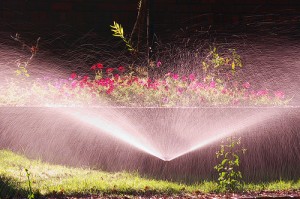
A sprinkler system with a timer can help you regulate when and for how long you water your lawn. http://www.flickr.com/photos/kumaravel/5505107751/
As we’re approaching summer, the heat and lack of precipitation has the potential to damage your lawn. Maintaining an appropriate watering schedule is essential to a healthy lawn, but it is also necessary to prevent waste in a time when water levels may be lower than normal. There are a few basic rules to follow when it comes to watering your lawn, but your grass will also provide you with very clear signs of when it does and does not need watering.
Some homeowners assume that grass will benefit no matter when or how much water you give it. However, improper watering can cause serious damage. It’s important to space out your watering to a couple of times a week and deliver a good dose of about ¼ of an inch, which usually takes about 30 minutes. If you water your lawn each day for just a few minutes, you can encourage shallow roots. It actually strengthens grass when they have to go without water for short periods of time because the roots will reach farther into the soil, strengthening your lawn. Providing your lawn with adequate amounts when you do water will allow the water to reach all the way to the roots and not just the surface of your lawn. Conversely, too much water can encourage the growth of certain fungi and diseases in your lawn, which is equally detrimental.
The time of day you water is also a huge factor. The most ideal time to water your lawn is in the morning before it gets too hot. This will minimize evaporation, providing your lawn with the optimal amount of moisture. When choosing your watering schedule each week, pay attention to the weather. Even if your grass is starting to show some signs of dehydration, but the week’s forecast shows rain, you can hold off and save water and money. Many lawn care professionals suggest approximately an inch of water a week, including rainfall, for a healthy lawn. This is not an exact specification and can vary. As always, pay attention to what your grass is telling you. If you notice footprints in your grass, this can be a sign of dehydration. This signals that the blades are weak; hence they don’t quickly spring back after being walked on. Discoloration of your lawn also indicates water is needed. Grass in need of water may also have blades that begin to curl at the tip. If you notice these signs, you may need to increase your watering levels.
No matter how much we all enjoy a lush, green lawn, if water levels in your area are extremely low, pay attention to city warnings. In times of drought, city officials may ban lawn watering and it is important to adhere to these regulations.